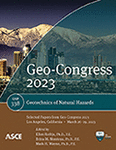Development and Verification of Non-Ergodic Ground-Motion Methodologies and Modeling Tools
Publication: Geo-Congress 2023
ABSTRACT
Non-ergodic ground-motion models (NGMMs) have the potential of reducing the ground-motion aleatory variability significantly, which has a large impact on the seismic hazard, especially at large return periods important for critical infrastructure. This reduction in aleatory variability is accompanied by epistemic uncertainty in regions with sparse recordings or a systematic shift in the median ground motion in regions with dense recordings. Gaussian process regression (GPR)—with spatially varying coefficients for modeling the source and site systematic effects and cell-specific anelastic attenuation for modeling the systematic path effects—is a flexible and robust modeling technique used in this study for developing NGMMs. As part of this work, open-source computer tools and instructions have been developed to show the steps toward developing NGMMs in the GPR framework. Statistical software packages STAN and INLA are used and compared. The developed software packages were tested against synthetic data sets with known non-ergodic effects, and different implementations of the developed software were evaluated for scalability, universality, precision, and model complexity.
Get full access to this article
View all available purchase options and get full access to this chapter.
REFERENCES
Abrahamson, N., Atkinson, G., Boore, D., Bozorgnia, Y., Campbell, K., Chiou, B., Idriss, I. M., Silva, W., and Youngs, R. (2008). Comparisons of the NGA ground-motion relations. Earthquake Spectra, 24(1), 45–66.
Abrahamson, N. A., Kuehn, N. M., Walling, M., and Landwehr, N. (2019). Probabilistic seismic hazard analysis in California using nonergodic ground‐motion models. Bulletin of the Seismological Society of America, 109(4), 1235–1249.
Akkar, S., and Çağnan, Z. (2010). A local ground-motion predictive model for Turkey, and its comparison with other regional and global ground-motion models. Bulletin of the Seismological Society of America, 100(6), 2978–2995.
Ancheta, T. D., et al. (2014). NGA-West2 database. Earthquake Spectra, 30(3), 989–1005.
Anderson, J. G., and Brune, J. N. (1999). Probabilistic seismic hazard analysis without the ergodic assumption. Seismological Research Letters, 70(1), 19–28.
Bozorgnia, Y., et al. (2014). NGA-West2 research project. Earthquake Spectra, 30(3), 973–987.
Coppersmith, K., et al. (2014). Hanford sitewide probabilistic seismic hazard analysis. Pacific Northwest National Laboratory, Richland Washington.
Dawood, H. M., and Rodriguez‐Marek, A. (2013). A method for including path effects in ground‐motion prediction equations: An example using the M w 9.0 Tohoku earthquake aftershocks. Bulletin of the Seismological Society of America, 103(2B), 1360–1372.
Douglas, J., et al. (2014). Comparisons among the five ground-motion models developed using RESORCE for the prediction of response spectral accelerations due to earthquakes in Europe and the Middle East. Bulletin of earthquake engineering, 12(1), 341–358.
Der Kiureghian, A., and Ditlevsen, O. (2009). Aleatory or epistemic? Does it matter?. Structural safety, 31(2), 105–112.
Kuehn, N. M., Abrahamson, N. A., and Walling, M. A. (2019). Incorporating nonergodic path effects into the NGA‐West2 ground‐motion prediction equations. Bulletin of the Seismological Society of America, 109(2), 575–585.
Kuehn, N. M., Bozorgnia, Y., Campbell, K. W., and Gregor, N. (2020). Partially Non-Ergodic Ground-Motion Model for Subduction Regions using the NGA-Subduction Database., September, PEER.
Landwehr, N., Kuehn, N. M., Scheffer, T., and Abrahamson, N. (2016). A nonergodic ground‐motion model for California with spatially varying coefficients. Bulletin of the Seismological Society of America, 106(6), 2574–2583.
Lavrentiadis, G., Abrahamson, N. A., and Kuehn, N. M. (2021a). A non-ergodic effective amplitude ground-motion model for California. Bulletin of Earthquake Engineering, 1–32.
Lavrentiadis, G., et al. (2021b). Overview and Introduction to Development of Non-Ergodic Earthquake Ground-Motion Models. arXiv preprint arXiv:2111.07921.
Lavrentiadis, G., Seylabi, E., Nicolas, K. M., Meng, X., Bozorgnia, Y., Goulet, C. A., and Kottke, A. R. (2022). Non-ergodic Methodology and Modeling Tools. August, B. John Garrick Institute for the Risk Sciences.
Lin, P. S., Chiou, B., Abrahamson, N., Walling, M., Lee, C. T., and Cheng, C. T. (2011). Repeatable source, site, and path effects on the standard deviation for empirical ground-motion prediction models. Bulletin of the Seismological Society of America, 101(5), 2281–2295.
Meng, X., and Goulet, C. (2021). Lessons Learned from Applying Varying Coefficient Model to Controlled Simulation Datasets.
Merkel, D. (2014). Docker: lightweight linux containers for consistent development and deployment. Linux Journal, 2014(239), 2.
Rasmussen, C., and Williams, C. (2006). Gaussian processes for machine learning.,(MIT press: Cambridge, MA).
Rue, H., Martino, S., and Chopin, N. (2009). Approximate Bayesian inference for latent Gaussian models using integrated nested Laplace approximations (with discussion). Journal of the Royal Statistical Society, Series B, 71(2),319–392.
Stan Development Team. (2022). Stan Modeling Language Users Guide and Reference Manual, 2.29. https://mc-stan.org.
Sung, C. H., Abrahamson, N. A., Kuehn, N. M., Traversa, P., and Zentner, I. (2022). A non-ergodic ground-motion model of Fourier amplitude spectra for France. Bulletin of Earthquake Engineering, 1–25.
Tselentis, G. A., Danciu, L., and Sokos, E. (2010). Probabilistic seismic hazard assessment in Greece–Part 2: Acceleration response spectra and elastic input energy spectra. Natural Hazards and Earth System Sciences, 10(1), 41–49.
Information & Authors
Information
Published In
History
Published online: Mar 23, 2023
ASCE Technical Topics:
- Business management
- Computer programming
- Computer software
- Computing in civil engineering
- Decision making
- Decision support systems
- Earthquake engineering
- Engineering fundamentals
- Gaussian process
- Geomechanics
- Geotechnical engineering
- Geotechnical investigation
- Ground motion
- Mathematics
- Methodology (by type)
- Practice and Profession
- Probability
- Research methods (by type)
- Seismic effects
- Seismic tests
- Soil dynamics
- Soil mechanics
- Stochastic processes
- Tests (by type)
- Verification
Authors
Metrics & Citations
Metrics
Citations
Download citation
If you have the appropriate software installed, you can download article citation data to the citation manager of your choice. Simply select your manager software from the list below and click Download.
